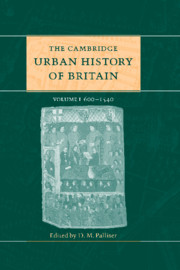Book contents
- Frontmatter
- Part I Introductory
- Part II The early middle ages 600–1300
- 3 General survey 600–1300
- 4 Power and authority 600–1300
- 5 Society and population 600–1300
- 6 The economy of British towns 600–1300
- 7 Churches, education and literacy in towns 600–1300
- 8 The topography of towns 600–1300
- 9 London from the post-Roman period to 1300
- 10 The large towns 600–1300
- 11 Small towns 600–1270
- Part III The later middle ages 1300–1540
- Part IV Regional surveys
- Part V Conclusion
- Appendix: Ranking lists of English medieval towns
- Select bibliography
- Index
- References
8 - The topography of towns 600–1300
from Part II - The early middle ages 600–1300
Published online by Cambridge University Press: 28 March 2008
- Frontmatter
- Part I Introductory
- Part II The early middle ages 600–1300
- 3 General survey 600–1300
- 4 Power and authority 600–1300
- 5 Society and population 600–1300
- 6 The economy of British towns 600–1300
- 7 Churches, education and literacy in towns 600–1300
- 8 The topography of towns 600–1300
- 9 London from the post-Roman period to 1300
- 10 The large towns 600–1300
- 11 Small towns 600–1270
- Part III The later middle ages 1300–1540
- Part IV Regional surveys
- Part V Conclusion
- Appendix: Ranking lists of English medieval towns
- Select bibliography
- Index
- References
Summary
Surveying the topography of towns before 1300 inevitably draws heavily on the disciplines of archaeology and plan analysis, rather than on documents and standing buildings, which are predominantly late medieval. Fortunately, the proliferation of urban excavations since the 1970s has produced a huge volume of topographical material, telling us much more about the siting, phases and layout of many towns than could be learnt from documents alone. This does not mean that we should neglect the value of early documents, however brief and laconic: the expert excavator of medieval Paris, Michel Fleury, demonstrates from personal experience ‘la nécessité d'allier constamment les données des sources écrites à celles que fournissent les fouilles archéologiques’. Nevertheless, there is much detail that we could never have gleaned of early medieval topography without excavation, and for the very earliest periods for the most crucial facts – whether a town site remained inhabited, or whether it was relocated – such evidence is all we have. It is therefore important that major discoveries of the past few years be built into general syntheses as soon as possible, and that is one of the purposes of this volume.
Most Roman town sites were also urban in the middle ages, and in most cases the Roman core lies beneath the modern town centre. However, to move from those premises to the conclusion of ‘continuity of site if not of urbanism’ is to go beyond the evidence. It is now clear that, of the four most important towns of the earliest post-Roman period, Ipswich was without a Roman past, while London and York developed on open sites outside the Roman walls before shifting back into the fortified area in the ninth and tenth centuries.
- Type
- Chapter
- Information
- The Cambridge Urban History of Britain , pp. 153 - 186Publisher: Cambridge University PressPrint publication year: 2000
References
- 3
- Cited by



